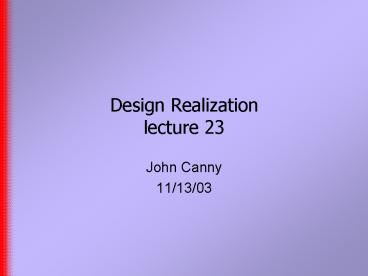Design Realization lecture 23 - PowerPoint PPT Presentation
1 / 20
Title:
Design Realization lecture 23
Description:
There is a companion to Matlab/Simulink called 'real-time workshop' (RTW). RTW automatically generates C code to run a Simulink model. ... – PowerPoint PPT presentation
Number of Views:132
Avg rating:3.0/5.0
Title: Design Realization lecture 23
1
Design Realization lecture 23
- John Canny
- 11/13/03
2
Last time
- Circuit design critique
- Control principles
- Simulation Matlab/Simulink
3
This time
- Finish circuit design critique
- Graphical programming and real-time control
(Simulink). - Automatic real-time code generation (Real-Time
Workshop).
4
PD Control
- In addition to position feedback, a multiple of
the velocity (derivative) is fed back as well to
stabilize the system
5
PD Stabilization
- Why does derivative feedback stabilize the
system? - Derivative feedback simulates a damper.
- Motion in a fluid creates viscous drag (F ? -v).
- Viscous drag quickly robs the system of energy.
6
PID Control
- Sometimes there is a residual error between
desired and actual output (not for DC motors). - Computing the integral of the difference signal
will reduce it to zero in the steady state.
7
PID Tracking Controller
- All three terms P,I,D are computed on the
difference signal
PID controller
8
Example2 Pendubot
- A two-axis robot. The first (blue) link is
driven, the second (red) link is passive. - The model includesgravity, and is
quitenon-linear.
9
Example2 Pendubot
- Use feedback and feedforward PID blocks to
stabilize two oscillatory modes.
10
Implementing PID Controllers
- Normally, the controller CPU is running at fixed
discrete time steps. - Derivatives can be computed by differencing
consecutive samples, integrals by summing samples
since time zero. - This approach introduces delays and can cause
problems at high frequency. - Make sure that amplifiers roll off at high
frequency use a low-pass amplifier.
11
Discrete lowpass amplifier
- Input is (x1,,xn), output is (y1,,yn)
- yk a yk-1 (1-a)b xk a, b
constants, a lt 1. - If x 0, y non-zero, then the amplifier outputs
a decreasing geometric sequence, which is a
discrete approximation to exponential decay. - It simulates a simple RC low-pass circuit.
12
Discrete lowpass amplifier
- The amplifiers DC Gain is b
- Corner frequency ?c (- ln a)/t 2?fcwhere t
is the discrete step time.
13
Transfer functions
- The variable s represents frequency
- T(s) 1/s is an integrator
- T(s) s is a derivative operator
- T(s) 1/(a bs) is a low-pass filter with
corner frequency a/b - T(s) (c ds) is a high-pass filter with corner
frequency c/d - T(s) (a bs)/(c ds) is a general gain block,
DC gain a/c, high frequency gain b/d.
14
Real-time Simulink execution
- Simulink does not have a real-time clock (at
least under Windows), and runs in virtual time. - It can be driven in real-time if one of its
blocks (especially input/output blocks) updates
at regular real-time speed. - The remainder of the Simulink code must run fast
enough to keep up.
15
Example Real-time Theremin Model
- 1-wire sensors control pitch and volume.
- Real-time sound output via sound card.
16
Example Real-time Simulink Model
- The simsound block includes a separate thread
which sends data to the sound card. - This thread signals the main program thread with
a semaphore when it is ready to accept data, or
when its buffer is full. - The buffer contains data with time stamps at the
desired real-time update rate. - Simulink runs a little faster than the sound card
update rate, and the sound thread interpolates
from Simulinks timestamps to real time.
17
Example Real-time Simulink Model
- The AtoD block also includes a separate thread to
acquire A-to-D input data. - This thread runs as fast as it can to provide the
most up-to-date sensor data to the running
simulation.
18
Automatic code generation
- There is a companion to Matlab/Simulink called
real-time workshop (RTW). - RTW automatically generates C code to run a
Simulink model. It can handle new user-defined
blocks (e.g. for sensor input or motor output). - This code can be compiled and run on the control
processor.
19
Automatic code generation
- RTW code generation includes scheduling and
event-handling and allows blocks to run at
different rates. - It also allows complicated models that may not
run correctly with a simple discrete-step
approximation.
20
Summary
- Feedback control methods PD and PID.
- Feedforward control.
- Real-time use of Simulink.
- Code generation with Real-Time Workshop.































